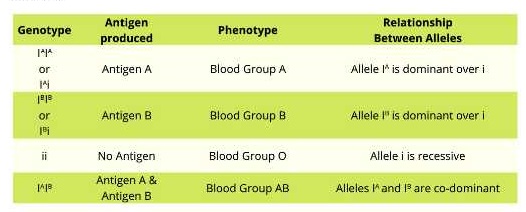Q.11 Define and explain co-dominance and Incomplete dominance with examples.
Answer:
Co-dominance
It is a situation where two different alleles of a gene pair express themselves completely instead of showing dominant-recessive relationship. As a result, heterozygous organism shows phenotype that is different from both homozygous parents.
Example
ABO Blood Group
Gene I
The ABO blood group system is controlled by gene I.
Alleles
Gene I has three alleles:
(a) IA
(b) IB
(c) I
Allele 1A
Allele IA produces antigen A in blood and the phenotype is blood group A.
Allele IB
Allele IB produces antigen B in blood and phenotype is blood group B.

Allele i
Allele i does not produce any antigen and the phenotype is blood group 0. Complete Dominance
Allele IA and I are completely dominant over allele i.
Genotype. IA IB
In heterozygous genotype IA IP, each of the two alleles produces the respective antigens and neither of them dominates over the other. So blood group will be AB.
Incomplete Dominance
It is a situation where in heterozygous genotypes, both the alleles express as a blend (mixture) and neither allele is dominant over the other. As a result of this blending, an intermediate phenotype is expressed.

Four O Clock plant
Flower colour
The trait of flower colour is controlled by two alleles i.e. ‘R’ and ‘r’..
Allele ‘R’
Allele ‘R’ is responsible for giving red colour to flower.
Allele ‘r’
Allele ‘r’ is responsible for giving white colour to flowers.
True Breeding Plants
True breeding plants ‘RR’ and ‘rr’ have red and white coloured flowers respectively.
Heterozygous plants of F1 Generation
When homozygous red flowered plant (RR) is crossed with homozygous white flowered plar (rr), the heterozygous (Rr) plants of F1 generation produce pink flowers.
Blending
Pink colour is blend of red and white colours.
F2 Generation
When two heterozygous plants with pink flowers (Rr) are crossed, F2 generation shows phenotype of red, pink and white flowers in the ratio 1:2:1.
Conclusion
Thus, it is concluded that neither of red flower allele (R) and white flower allele (r) is dominant.

![]()